Water Enforcement
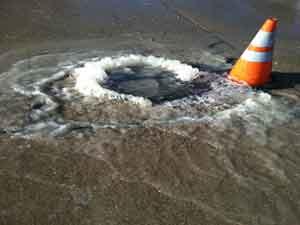
Too much rain can sometimes cause overflows at sewage treatment plants, pushing raw sewage out of sewers and into city streets.
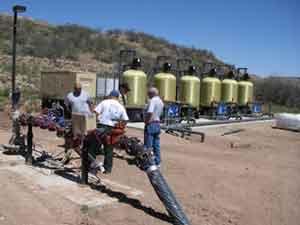
EPA and Indian Health Service inspect a drinking water plant on the Yavapai Apache Nation reservation in Arizona.
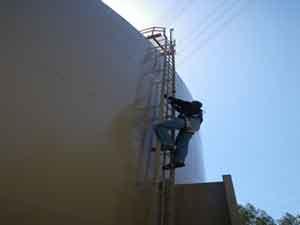
During inspections of drinking water treatment plants, inspectors must climb to the top of the storage tank to check the condition of the tank.
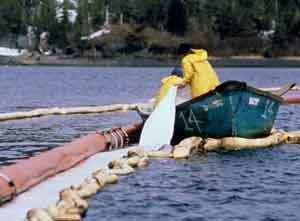
EPA field personnel using booms and absorbent pads to clean up an oil spill in the Pacific Northwest.
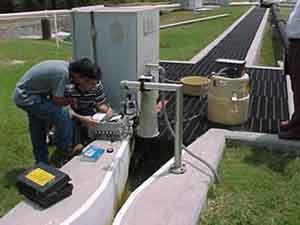
EPA inspectors preparing to measure discharge flow during an inspection of a NPDES-permitted wastewater treatment plant in Georgia.
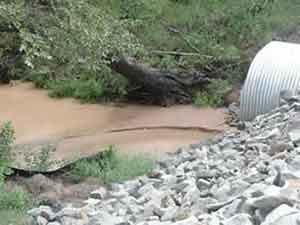
This photo shows an Oklahoma creek that has been polluted with sediment from the activities of a nearby oil and gas drill site.
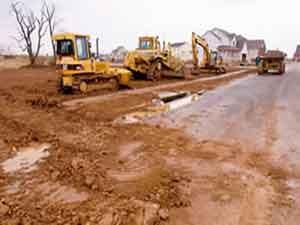
Construction sites are required to minimize stormwater pollution by stabilizing exposed dirt and placing filters around storm drains to catch dirt and other debris.
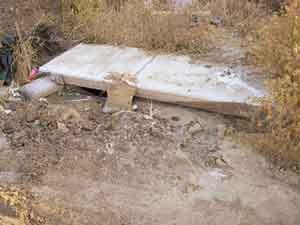
(Cont) Two sand bags were not sufficient to keep dirt and other debris from entering this storm drain.
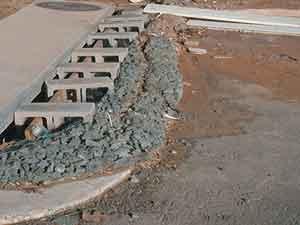
(Cont) At this construction site, cinder blocks and gravel were effective in keeping sediment out of the storm drain.
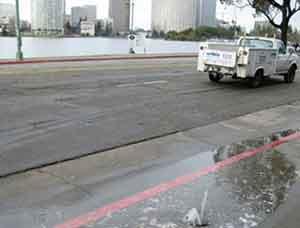
In a 2009 settlement, the East Bay Municipal District agreed to address inadequately treated sewage discharges that were spilling into the San Francisco Bay during wet weather.
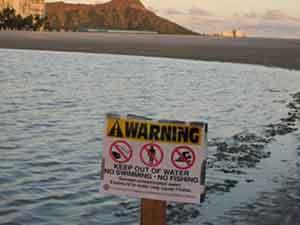
In 2006, a sewage spill caused partial closure of Waikiki Beach. Honolulu paid a $1.6 million penalty and agreed to upgrade its wastewater system.
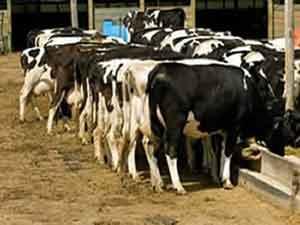
Concentrated Animal Feeding Operations (CAFOs) generate large volumes of animal waste which can contaminated drinking water sources, kill fish, and transmit bacteria.
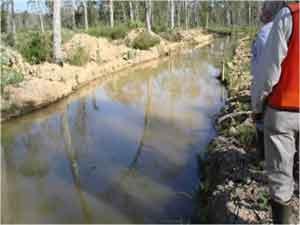
EPA enforced against a logging company that disposed of fill material in this Louisiana wetland without a permit, in violation of the Clean Water Act.
Información relacionada disponible en español (Related Information in Spanish)
EPA enforces requirements under the Clean Water Act (CWA) and Safe Drinking Water Act (SDWA). For more on EPA's enforcement process, go to Basics on enforcement.
On this page:
- Clean Water Act
- Clean Water Act Compliance Monitoring and Assistance
- Framework for Protecting Public and Private Investment in Clean Water Act Enforcement Remedies
- Safe Drinking Water Act
- Safe Drinking Water Act Compliance Monitoring and Assistance
On other pages:
- Water Enforcement Policy, Guidance and Publications
- Search for water cases and settlements
- Find safe drinking water enforcement data
- Find National Clean Water Act enforcement data
- National Pollutants Discharge Elimination System permits
Clean Water Act
Wastewater Management. Under the CWA's National Pollutant Discharge Elimination System (NPDES) program, EPA regulates discharges of pollutants from municipal and industrial wastewater treatment plants, sewer collection systems, and stormwater discharges from industrial facilities and municipalities. The Clean Water Action Plan targets enforcement to the most important water pollution problems.
-
Municipal Wastewater and Stormwater Management. Overflows of raw sewage and inadequately controlled stormwater discharges from municipal sewer systems can end up in waterways or cause back ups into city streets or basements of homes threatening water quality, human health and the environment. EPA is targeting large municipalities to reduce pollution and volume of stormwater runoff and to reduce unlawful discharges of raw sewage that degrade water quality in communities. Reducing raw sewage overflows and stormwater discharges is one of EPA's National Enforcement Initiatives.
-
Pretreatment. EPA enforces requirements to ensure that industries pre-treat pollutants in their wastes in order to protect local sanitary sewers and wastewater treatment plants. Industrial discharges of metals, oil and grease, and other pollutants can interfere with the operation of local sanitary sewers and wastewater treatment plants, leading to the discharge of untreated or inadequately treated pollutants into local waterways. Learn more about pretreatment.
-
-
Stormwater Pollution. This occurs when debris, chemicals, sediment or other pollutants from urban areas and construction sites get washed into storm drains and flows directly into water bodies. Uncontrolled stormwater discharges can pose significant threats to public health and the environment. The CWA requires that industrial facilities, construction sites, and municipal separate storm sewer systems (MS4s) have measures in place to prevent pollution from being discharged with stormwater into nearby waterways. Reducing discharges of contaminated stormwater into our nation's rivers, streams and lakes waterways is one of EPA's National Enforcement Initiatives.
Animal Waste and Illegally discharging pollutants to water. CAFOs that are not controlling their animal wastes and illegally discharging pollutants to water bodies are a serious threat to water quality and human health. Taking action to compel these operations to properly control their wastes and comply with the law is one of EPA's National Enforcement Initiatives.
Spills - Oil and Hazardous Substances. Oil spills can harm animal and plant life, contaminating food sources and nesting habitats. Petroleum oils can form tars that persist in the environment for years. The CWA prohibits oil or hazardous substance spills in quantities that may be harmful to human health and the environment and requires actions to prevent future spills.
Wetlands - Discharges of Dredge and Fill Material. EPA ensures that dredged or fill material is not discharged into wetlands and other waters of the United States except as authorized by a permit issued by the United States Army Corps of Engineers. EPA investigates and inspects those discharging dredge and fill material into wetlands and other waters of the United States without a permit and pursues appropriate enforcement to ensure compliance. Learn more about wetlands.
Deepwater Horizon – BP Gulf of Mexico Oil Spill. On April 20, 2010, the oil drilling rig Deepwater Horizon, operating in the Macondo Prospect in the Gulf of Mexico, exploded and sank resulting in the death of 11 workers on the Deepwater Horizon and the largest spill of oil in the history of marine oil drilling operations. Learn more about Deepwater Horizon.
Clean Water Act Compliance Monitoring and Assistance
EPA works with its federal, state and tribal regulatory partners through a comprehensive Clean Water Act compliance monitoring program to protect human health and the environment by ensuring that the regulated community obeys environmental laws/regulations through on-site visits by qualified inspectors, and a review of the information EPA or a state/tribe requires to be submitted. The CWA compliance assistance program provides businesses, federal facilities, local governments and tribes with tools to help meet environmental regulatory requirements.
Framework for Protecting Public and Private Investment in Clean Water Act Enforcement Remedies
- The goal of this framework is to ensure that remedies in Clean Water Act (CWA) enforcement actions are resilient in the face of climate impacts, such as sea level rise, flooding, and drought, which will increasingly affect water infrastructure and regulated entities’ ability to comply with CWA requirements. This framework relies on the use of common sense measures for protecting people, the environment and economic investments from the impacts of a changing climate.
Safe Drinking Water Act (SDWA)
Drinking Water. EPA safeguards human health by enforcing the requirements of the SDWA to ensure that the nation's public drinking water supply and its sources (rivers, lakes, reservoirs, springs, and ground water wells) are protected. Learn more about drinking water.
- Public Drinking Water Systems. EPA ensures that public drinking water systems comply with health-based federal standards for contaminants, which includes performing regular monitoring and reporting.
- Underground Injection Control. Underground injection is the technology of placing fluids underground, in porous formations of rocks, through wells or other similar conveyance systems. EPA ensures that underground injection wells do not endanger any current and future underground or surface sources of drinking water. EPA investigates and inspects those injecting fluids underground in violation of the SDWA and pursues appropriate enforcement to ensure compliance. Learn more about energy extraction.
- Aircraft Drinking Water Rule. EPA is responsible for ensuring the safety of drinking water on aircraft and is working with airlines to ensure drinking water quality to include making certain that the airlines are in compliance with the recently promulgated Aircraft Drinking Water Rule.
Safe Drinking Water Act Compliance Monitoring and Assistance
EPA works with its federal, state and tribal regulatory partners through a comprehensive Safe Drinking Water Act compliance monitoring program to protect human health and the environment by ensuring that the regulated community obeys environmental laws/regulations through on-site visits by qualified inspectors, and a review of the information EPA or a state/tribe requires to be submitted. The SDWA compliance assistance program provides businesses, federal facilities, local governments and tribes with tools to help meet environmental regulatory requirements.


